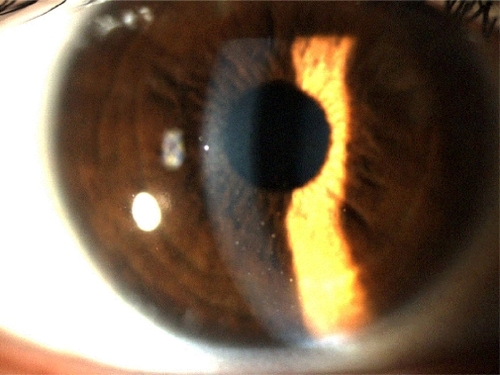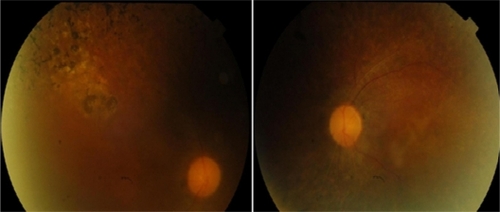Abstract
We report a case of Usher syndrome in association with unilateral Fuchs’ heterochromic uveitis.
Introduction
Usher syndrome is the most common cause of deafness and blindness.Citation1 The disorder has been reported to have various presentations according to age of onset, severity, hearing tests, ocular symptoms, and, more recently, electroretinographic findings. The presentations of Usher syndrome are defined as type 1, type 2, and type 3. Type 1 is the most severe, type 2 is of moderate severity (and the most common), and type 3 is of the mildest severity and has the slowest progression.Citation1,Citation2
Fuchs’ heterochromic uveitis is a chronic nongranulomatous uveitis which is seen most commonly in patients aged 20–40 years.Citation3 Its reported incidence is 0.2%.Citation3,Citation4 Fuchs’ heterochromic uveitis accounts for 1%–6% of all cases of uveitis.Citation4 It has been associated with various retinal diseases, including toxoplasmosis and traumatic scars.Citation3,Citation4 In this case report, we report the case of a patient with Usher syndrome in association with Fuchs’ heterochromic uveitis.
Case report
A 35-year-old woman presented to our clinic in October 2010 because of progressive bilateral reduction of vision and hearing since childhood. Systemic examination demonstrated no remarkable findings, except for hearing loss. Family history revealed that other members of the family were unaffected. Visual acuity was reduced to counting fingers at 1 m for the right eye and 2 m for the left eye. Biomicroscopic examination showed normal conjunctiva, flattened iridic crypts in the right eye, endothelial stellate keratic precipitates, a mild uveitic reaction in the anterior chamber, and bilateral intensive posterior subcapsular cataract (). There were no associated posterior synechiae in either eye. Mild vitreous condensation was observed. Her intraocular pressures were 14 mmHg in the right eye and 16 mmHg in the left eye. Gonioscopy showed no vascular abnormality in the angle. Examination of the dilated binocular fundus demonstrated waxy pallor in the papillae, marked vasoconstriction in the retinal vessels, and retinal bone spicule pigment formation, with a normal macula (). Optical coherence tomography showed normal macular volume and thickness. The pattern electroretinogram displayed a reduced response (). A threshold hearing test showed total bilateral hearing loss. In light of these findings, we made a diagnosis of type 2 Usher syndrome associated with Fuchs’ heterochromic uveitis. Relatives of the patient were not affected.
Discussion
Usher syndrome is the most common form of combined hearing and vision loss.Citation1,Citation2 Its frequency is reported to be 1/20000.Citation1 Usher syndrome is the most common syndrome associated with retinitis pigmentosa,Citation5 and is known to accompany 14% of cases.Citation4 There are many reports of the association of Fuchs’ heterochromic uveitis and retinitis pigmentosa.49 The etiology of Fuchs’ heterochromic uveitis is not clear, and definitions involve many concurrent retinal diseases.Citation3–Citation6 The association of retinitis pigmentosa and Fuchs’ heterochromic uveitis was first reported in 1940,Citation4 and assumed to be coincidental. Since then, there have been 14 reported cases of retinitis pigmentosa associated with Fuchs’ heterochromic uveitis, and the association is no longer regarded as a coincidence.Citation4,Citation7 An autoimmune process is believed to facilitate the ocular inflammation in retinitis pigmentosa.Citation7 The association of Usher syndrome and Fuchs’ heterochromic uveitis has only been reported twice in the literature.Citation4 Both were in patients with type 2 Usher syndrome.
In retinitis pigmentosa, retinal antigens may lead to an autoimmune antigenic reaction in the anterior chamber.Citation4 In many forms of hereditary degeneration and uveitis, autoimmune reactions have been shown against retinal S antigen, a protein of the outer segment of the retinal rod. A B cell reaction against retinal S antigen has been demonstrated in patients with retinitis pigmentosa. While S antigen reactivity is found in 15% of patients with retinitis pigmentosa, it has been found to occur in 80% of patients with Usher syndrome.Citation4–Citation10 All the abovementioned data indicate that the association of Fuchs’ heterochromic uveitis and Usher syndrome is not coincidental, and represents an autoimmune reaction.
Disclosure
The authors report no conflicts of interest in this work.
References
- KremerHvan WijkEMärkerTWolfrumURoepmanRUsher syndrome: Molecular links of pathogenesis, proteins and pathwaysHum Mol Genet200615262270
- YanDLiuXZGenetics and pathological mechanisms of Usher syndromeJ Hum Genet20105532733520379205
- Tugal-TutkunİGüney-TefekliEKamaci-DumanFCorumIA cross-sectional and longitudinal study of Fuchs’ uveitis syndrome in Turkish patientsAm J Ophthalmol200914851051519477709
- LichtingerAChowersIAmerRUsher syndrome associated with Fuchs’ heterochromic uveitisGraefes Arch Exp Ophthalmol201024814811485
- RosenbergTHaimMHaunchAMParvingAThe prevalence of Usher syndrome and other retinal dystrophy-hearing impairment associationsClin Genet1997513143219212179
- ChowersIZamirEBaninEMerinSRetinitis pigmentosa associated with Fuchs’ heterochromatic üveitisArch Ophthalmol200011880080210865317
- SandinhaTRetinitis pigmentosa associated with Fuchs’ heterochromatic üveitisEye20031477877912928695
- YalvaçISAltintaşAKGökdereADumanSFuchs’ heterochromic üveitis associated with retinitis pigmentosaActa Ophthalmol Scand1998762432449591963
- Van den BornLIvan SchooneveldMJde JongPTBleeker-WagemakersEMFuchs’ heterochromic üveitis associated with retinitis pigmentosa in a father and sonBr J Ophthalmol1994785045058060947
- RuokonenPCMetznerSUcerATorunNHofmannJPleyerUIntraocular antibody synthesis against rubella virus and other microorganisms in Fuchs’ heterochromic cyclitisGraefes Arch Clin Exp Ophthalmol201024856557119937050


